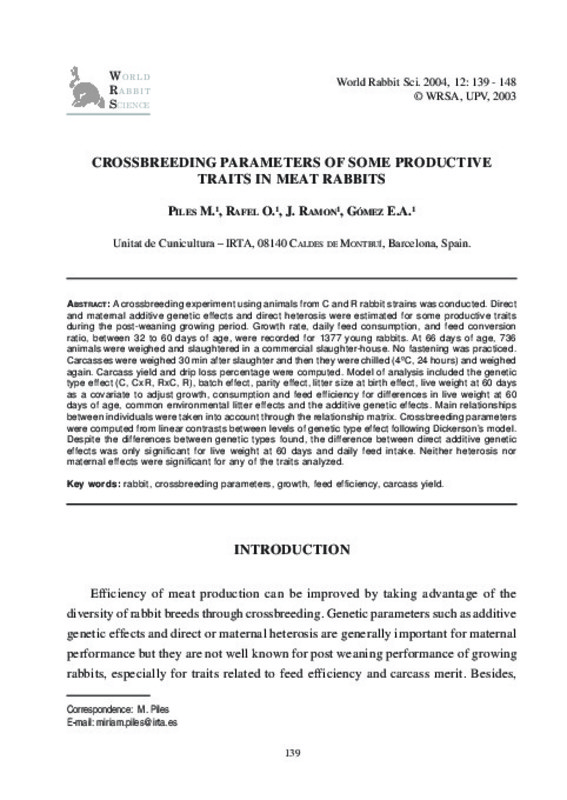JavaScript is disabled for your browser. Some features of this site may not work without it.
Buscar en RiuNet
Listar
Mi cuenta
Estadísticas
Ayuda RiuNet
Admin. UPV
Crossbreeding parameters of some productive traits in meat rabbits
Mostrar el registro sencillo del ítem
Ficheros en el ítem
| dc.contributor.author | Piles, M.
|
|
| dc.contributor.author | Rafel, O.
|
|
| dc.contributor.author | Ramon, J.
|
|
| dc.contributor.author | Gómez, E.A.
|
|
| dc.date.accessioned | 2011-02-14T11:13:49Z | |
| dc.date.available | 2011-02-14T11:13:49Z | |
| dc.date.issued | 2004 | |
| dc.identifier.issn | 1257-5011 | |
| dc.identifier.uri | http://hdl.handle.net/10251/9782 | |
| dc.description.abstract | [EN] A crossbreeding experiment using animals from C and R rabbit strains was conducted. Direct and maternal additive genetic effects and direct heterosis were estimated for some productive traits during the post-weaning growing period. Growth rate, daily feed consumption, and feed conversion ratio, between 32 to 60 days of age, were recorded for 1377 young rabbits. At 66 days of age, 736 animals were weighed and slaughtered in a commercial slaughter-house. No fastening was practiced. Carcasses were weighed 30 min after slaughter and then they were chilled (4ºC, 24 hours) and weighed again. Carcass yield and drip loss percentage were computed. Model of analysis included the genetic type effect (C, CxR, RxC, R), batch effect, parity effect, litter size at birth effect, live weight at 60 days as a covariate to adjust growth, consumption and feed efficiency for differences in live weight at 60 days of age, common environmental litter effects and the additive genetic effects. Main relationships between individuals were taken into account through the relationship matrix. Crossbreeding parameters were computed from linear contrasts between levels of genetic type effect following Dickerson's model. Despite the differences between genetic types found, the difference between direct additive genetic effects was only significant for live weight at 60 days and daily feed intake. Neither heterosis nor maternal effects were significant for any of the traits analyzed. | es_ES |
| dc.description.sponsorship | Research was supported by INIA SC00-011. The authors acknowledge the staff of the farm at IRTA (N. Picornell, O. Perucho, N. Aloy and C. Requena) for their contribution to the experimental work. | |
| dc.language | Inglés | es_ES |
| dc.publisher | World Rabbit Science. ICTA. UPV | es_ES |
| dc.relation.ispartof | World Rabbit Science | |
| dc.rights | Reserva de todos los derechos | es_ES |
| dc.subject | Rabbit | es_ES |
| dc.subject | Crossbreeding parameters | es_ES |
| dc.subject | Growth | es_ES |
| dc.subject | Feed efficiency | es_ES |
| dc.subject | Carcass yield | es_ES |
| dc.title | Crossbreeding parameters of some productive traits in meat rabbits | es_ES |
| dc.type | Artículo | es_ES |
| dc.date.updated | 2011-02-14T11:09:59Z | |
| dc.identifier.doi | 10.4995/wrs.2004.575 | |
| dc.relation.projectID | info:eu-repo/grantAgreement/MICYT//SC00-011/ES/Estimación de parámetros genéticos del carácter índice de conversión en dos líneas especializadas en crecimiento. Estudio de la cinética de producción de semen y posible interés del cruce dialélico entre líneas seleccionadas/ | |
| dc.rights.accessRights | Abierto | es_ES |
| dc.description.bibliographicCitation | Piles, M.; Rafel, O.; Ramon, J.; Gómez, E. (2004). Crossbreeding parameters of some productive traits in meat rabbits. World Rabbit Science. 12(3):139-148. https://doi.org/10.4995/wrs.2004.575 | es_ES |
| dc.description.accrualMethod | SWORD | es_ES |
| dc.relation.publisherversion | https://doi.org/10.4995/wrs.2004.575 | |
| dc.description.upvformatpinicio | 139 | |
| dc.description.upvformatpfin | 148 | |
| dc.description.volume | 12 | |
| dc.description.issue | 3 | |
| dc.identifier.eissn | 1989-8886 | es_ES |
| dc.contributor.funder | Ministerio de Ciencia y Tecnología |








